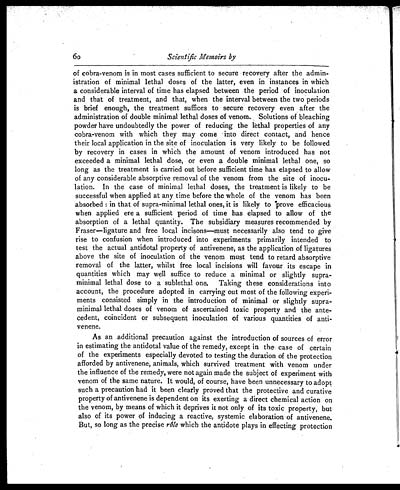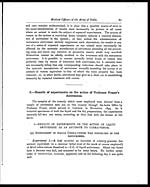Medicine - Institutions > Army health reports and medical documents > Scientific memoirs by medical officers of the Army of India > Part X, 1897 > 4 - Report on the results of experiments on the action of various reputed antidotes to snake-venom conducted during the season 1895-96
(81) Page 60
Download files
Individual page:
Thumbnail gallery: Grid view | List view

60
Scientific Memoirs by
of cobra-venom is in most cases sufficient to secure recovery after the admin-
istration of minimal lethal doses of the latter, even in instances in which
a considerable interval of time has elapsed between the period of inoculation
and that of treatment, and that, when the interval between the two periods
is brief enough, the treatment suffices to secure recovery even after the
administration of double minimal lethal doses of venom. Solutions of bleaching
powder have undoubtedly the power of reducing the lethal properties of any
cobra-venom with which they may come into direct contact, and hence
their local application in the site of inoculation is very likely to be followed
by recovery in cases in which the amount of venom introduced has not
exceeded a minimal lethal dose, or even a double minimal lethal one, so
long as the treatment is carried out before sufficient time has elapsed to allow
of any considerable absorptive removal of the venom from the site of inocu-
lation. In the case of minimal lethal doses, the treatment is likely to be
successful when applied at any time before the whole of the venom has been
absorbed: in that of supra-minimal lethal ones, it is likely to prove efficacious
when applied ere a sufficient period of time has elapsed to allow of the
absorption of a lethal quantity. The subsidiary measures recommended by
Fraser—ligature and free local incisons—must necessarily also tend to give
rise to confusion when introduced into experiments primarily intended to
test the actual antidotal property of antivenene, as the application of ligatures
above the site of inoculation of the venom must tend to retard absorptive
removal of the latter, whilst free local incisions will favour its escape in
quantities which may well suffice to reduce a minimal or slightly supra-
minimal lethal dose to a sublethal one. Taking these considerations into
account, the procedure adopted in carrying out most of the following experi-
ments consisted simply in the introduction of minimal or slightly supra-
minimal lethal doses of venom of ascertained toxic property and the ante-
cedent, coincident or subsequent inoculation of various quantities of anti-
venene.
As an additional precaution against the introduction of sources of error
in estimating the antidotal value of the remedy, except in the case of certain
of the experiments especially devoted to testing the duration of the protection
afforded by antivenene, animals, which survived treatment with venom under
the influence of the remedy, were not again made the subject of experiment with
venom of the same nature. It would, of course, have been unnecessary to adopt
such a precaution had it been clearly proved that the protective and curative
property of antivenene is dependent on its exerting a direct chemical action on
the venom, by means of which it deprives it not only of its toxic property, but
also of its power of inducing a reactive, systemic elaboration of antivenene.
But, so long as the precise rôle which the antidote plays in effecting protection
Set display mode to: Large image | Zoom image | Transcription
Images and transcriptions on this page, including medium image downloads, may be used under the Creative Commons Attribution 4.0 International Licence unless otherwise stated. ![]()
| Permanent URL | https://digital.nls.uk/75003294 |
|---|
| Shelfmark | IP/QB.10 |
|---|---|
| Additional NLS resources: | |



![[Page 59]](https://deriv.nls.uk/dcn4/7500/75003293.4.jpg)
